FORD F650 2016 13.G Owners Manual
Manufacturer: FORD, Model Year: 2016, Model line: F650, Model: FORD F650 2016 13.GPages: 379, PDF Size: 4.8 MB
Page 141 of 379
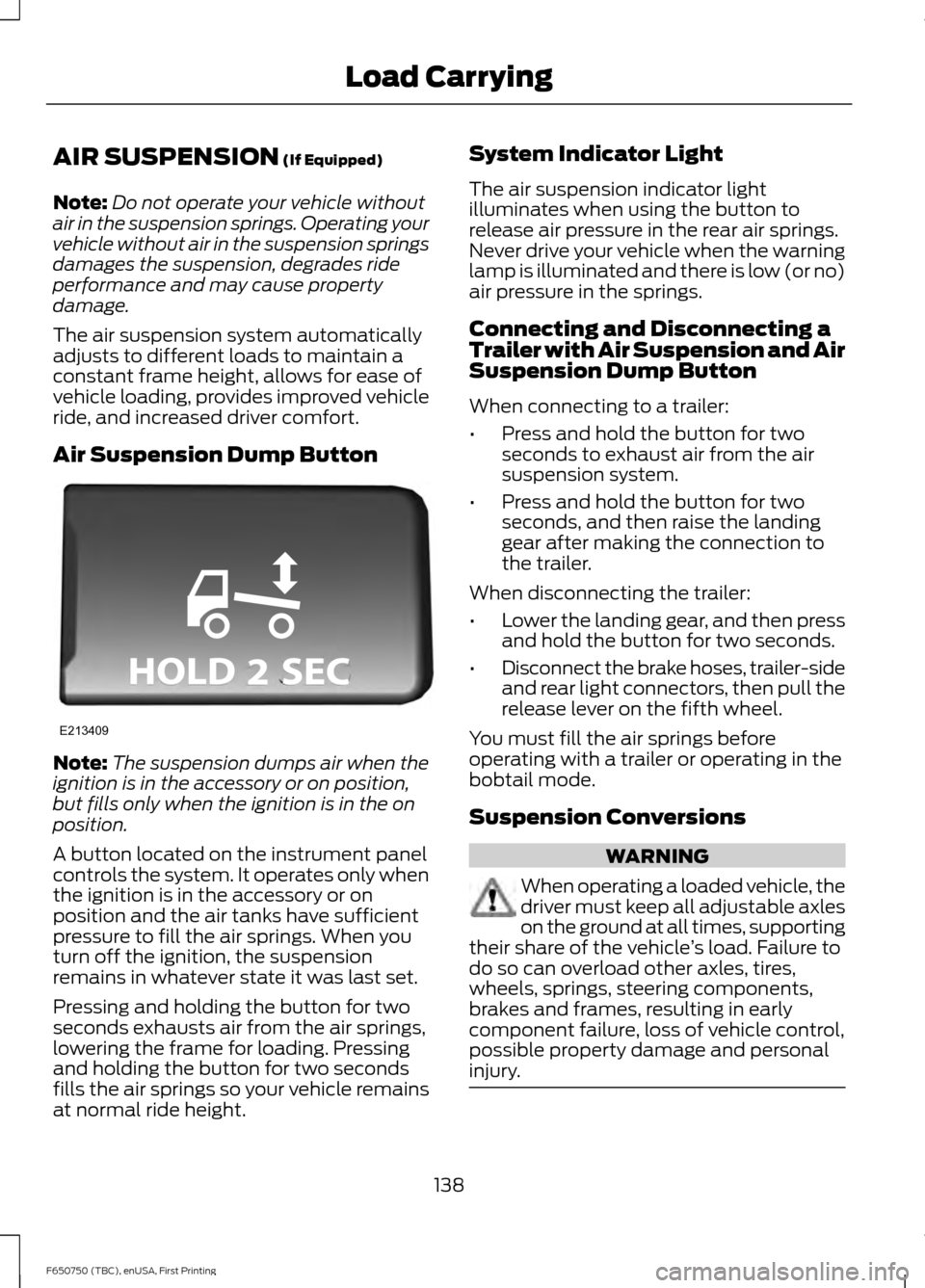
AIR SUSPENSION (If Equipped)
Note: Do not operate your vehicle without
air in the suspension springs. Operating your
vehicle without air in the suspension springs
damages the suspension, degrades ride
performance and may cause property
damage.
The air suspension system automatically
adjusts to different loads to maintain a
constant frame height, allows for ease of
vehicle loading, provides improved vehicle
ride, and increased driver comfort.
Air Suspension Dump Button Note:
The suspension dumps air when the
ignition is in the accessory or on position,
but fills only when the ignition is in the on
position.
A button located on the instrument panel
controls the system. It operates only when
the ignition is in the accessory or on
position and the air tanks have sufficient
pressure to fill the air springs. When you
turn off the ignition, the suspension
remains in whatever state it was last set.
Pressing and holding the button for two
seconds exhausts air from the air springs,
lowering the frame for loading. Pressing
and holding the button for two seconds
fills the air springs so your vehicle remains
at normal ride height. System Indicator Light
The air suspension indicator light
illuminates when using the button to
release air pressure in the rear air springs.
Never drive your vehicle when the warning
lamp is illuminated and there is low (or no)
air pressure in the springs.
Connecting and Disconnecting a
Trailer with Air Suspension and Air
Suspension Dump Button
When connecting to a trailer:
•
Press and hold the button for two
seconds to exhaust air from the air
suspension system.
• Press and hold the button for two
seconds, and then raise the landing
gear after making the connection to
the trailer.
When disconnecting the trailer:
• Lower the landing gear, and then press
and hold the button for two seconds.
• Disconnect the brake hoses, trailer-side
and rear light connectors, then pull the
release lever on the fifth wheel.
You must fill the air springs before
operating with a trailer or operating in the
bobtail mode.
Suspension Conversions WARNING
When operating a loaded vehicle, the
driver must keep all adjustable axles
on the ground at all times, supporting
their share of the vehicle ’s load. Failure to
do so can overload other axles, tires,
wheels, springs, steering components,
brakes and frames, resulting in early
component failure, loss of vehicle control,
possible property damage and personal
injury. 138
F650750 (TBC), enUSA, First Printing Load CarryingE213409
Page 142 of 379
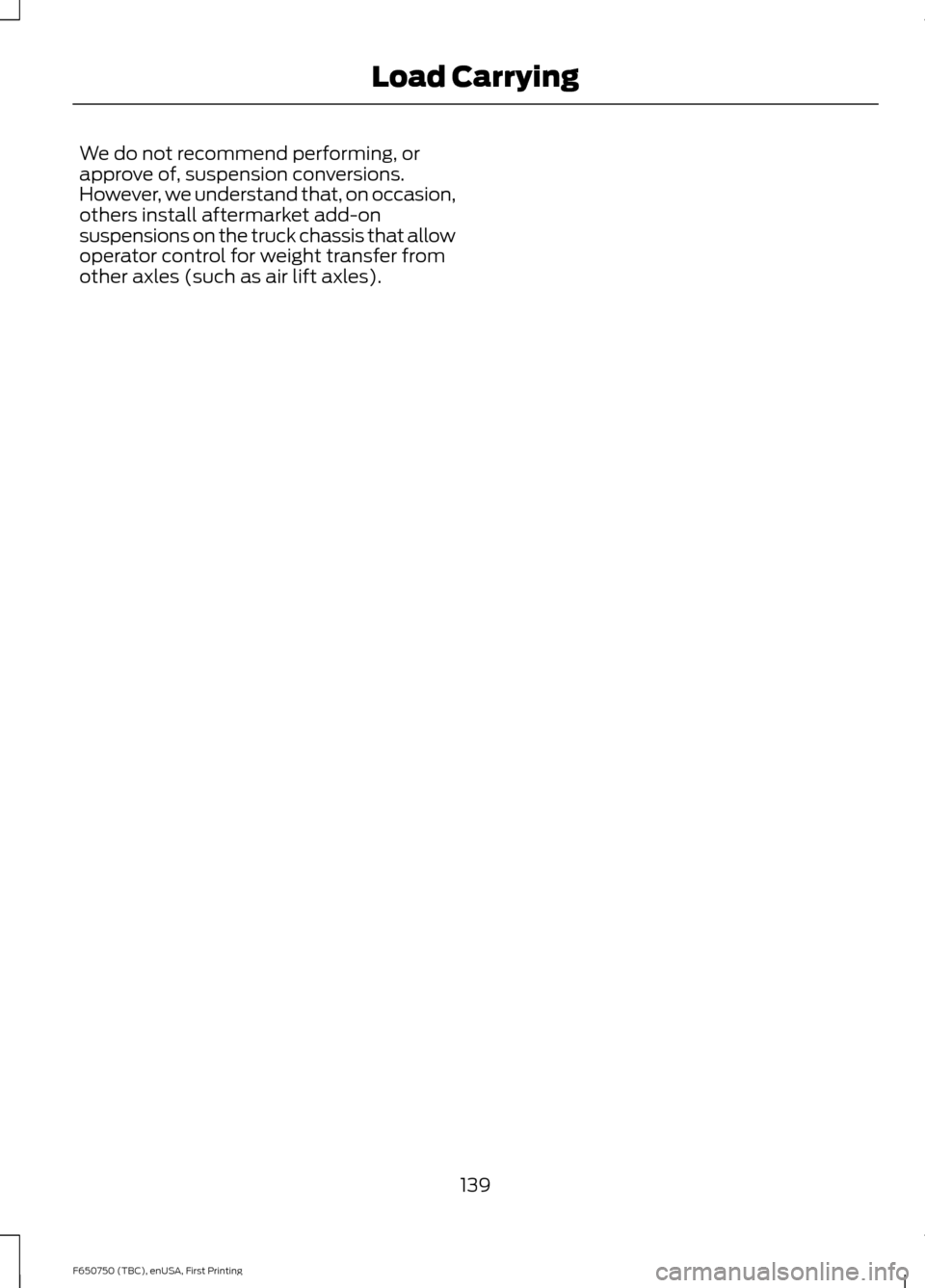
We do not recommend performing, or
approve of, suspension conversions.
However, we understand that, on occasion,
others install aftermarket add-on
suspensions on the truck chassis that allow
operator control for weight transfer from
other axles (such as air lift axles).
139
F650750 (TBC), enUSA, First Printing Load Carrying
Page 143 of 379
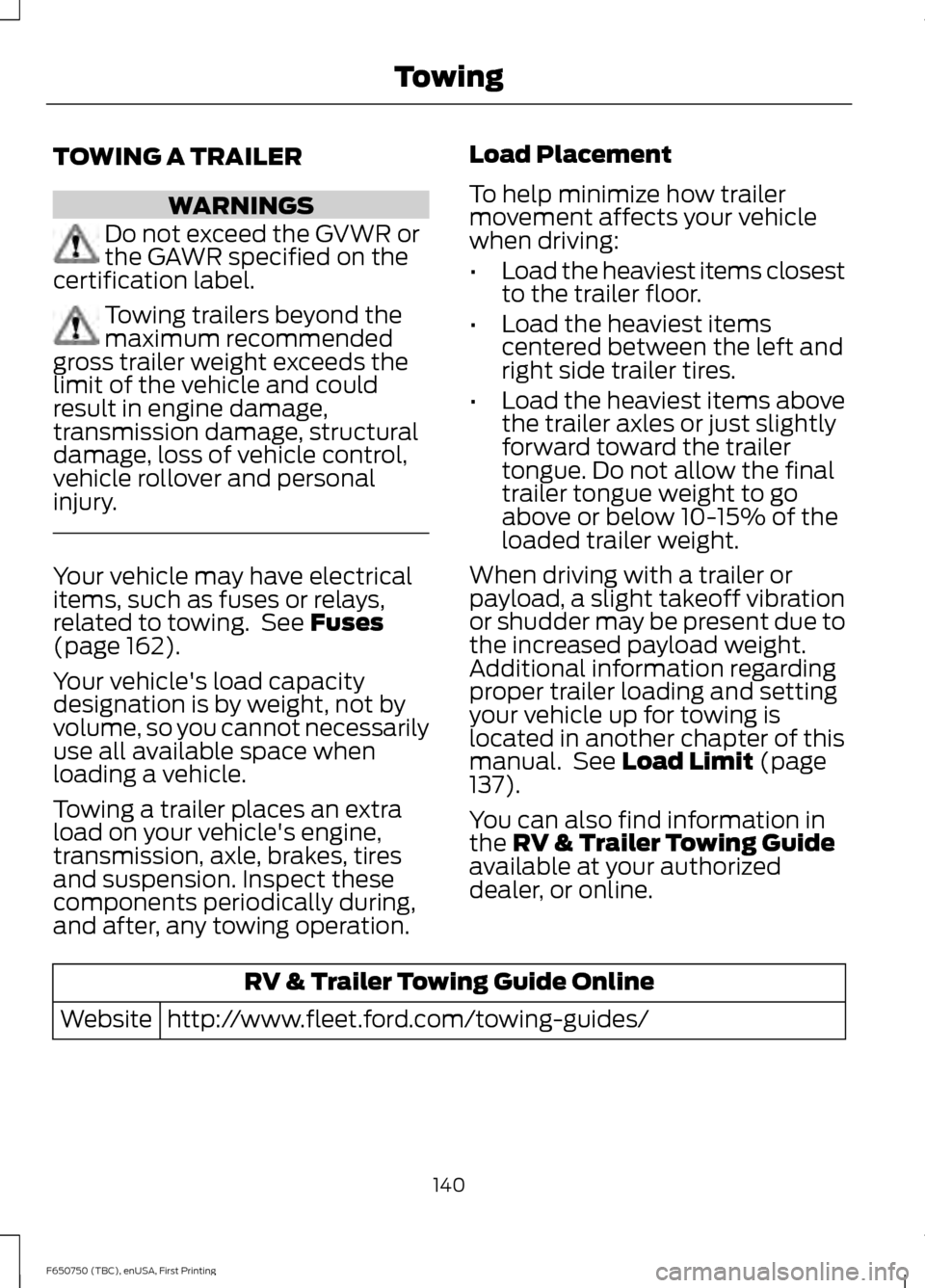
TOWING A TRAILER
WARNINGS
Do not exceed the GVWR or
the GAWR specified on the
certification label. Towing trailers beyond the
maximum recommended
gross trailer weight exceeds the
limit of the vehicle and could
result in engine damage,
transmission damage, structural
damage, loss of vehicle control,
vehicle rollover and personal
injury. Your vehicle may have electrical
items, such as fuses or relays,
related to towing. See Fuses
(page 162).
Your vehicle's load capacity
designation is by weight, not by
volume, so you cannot necessarily
use all available space when
loading a vehicle.
Towing a trailer places an extra
load on your vehicle's engine,
transmission, axle, brakes, tires
and suspension. Inspect these
components periodically during,
and after, any towing operation. Load Placement
To help minimize how trailer
movement affects your vehicle
when driving:
•
Load the heaviest items closest
to the trailer floor.
• Load the heaviest items
centered between the left and
right side trailer tires.
• Load the heaviest items above
the trailer axles or just slightly
forward toward the trailer
tongue. Do not allow the final
trailer tongue weight to go
above or below 10-15% of the
loaded trailer weight.
When driving with a trailer or
payload, a slight takeoff vibration
or shudder may be present due to
the increased payload weight.
Additional information regarding
proper trailer loading and setting
your vehicle up for towing is
located in another chapter of this
manual. See
Load Limit (page
137).
You can also find information in
the
RV & Trailer Towing Guide
available at your authorized
dealer, or online. RV & Trailer Towing Guide Online
http://www.fleet.ford.com/towing-guides/
Website
140
F650750 (TBC), enUSA, First Printing Towing
Page 144 of 379
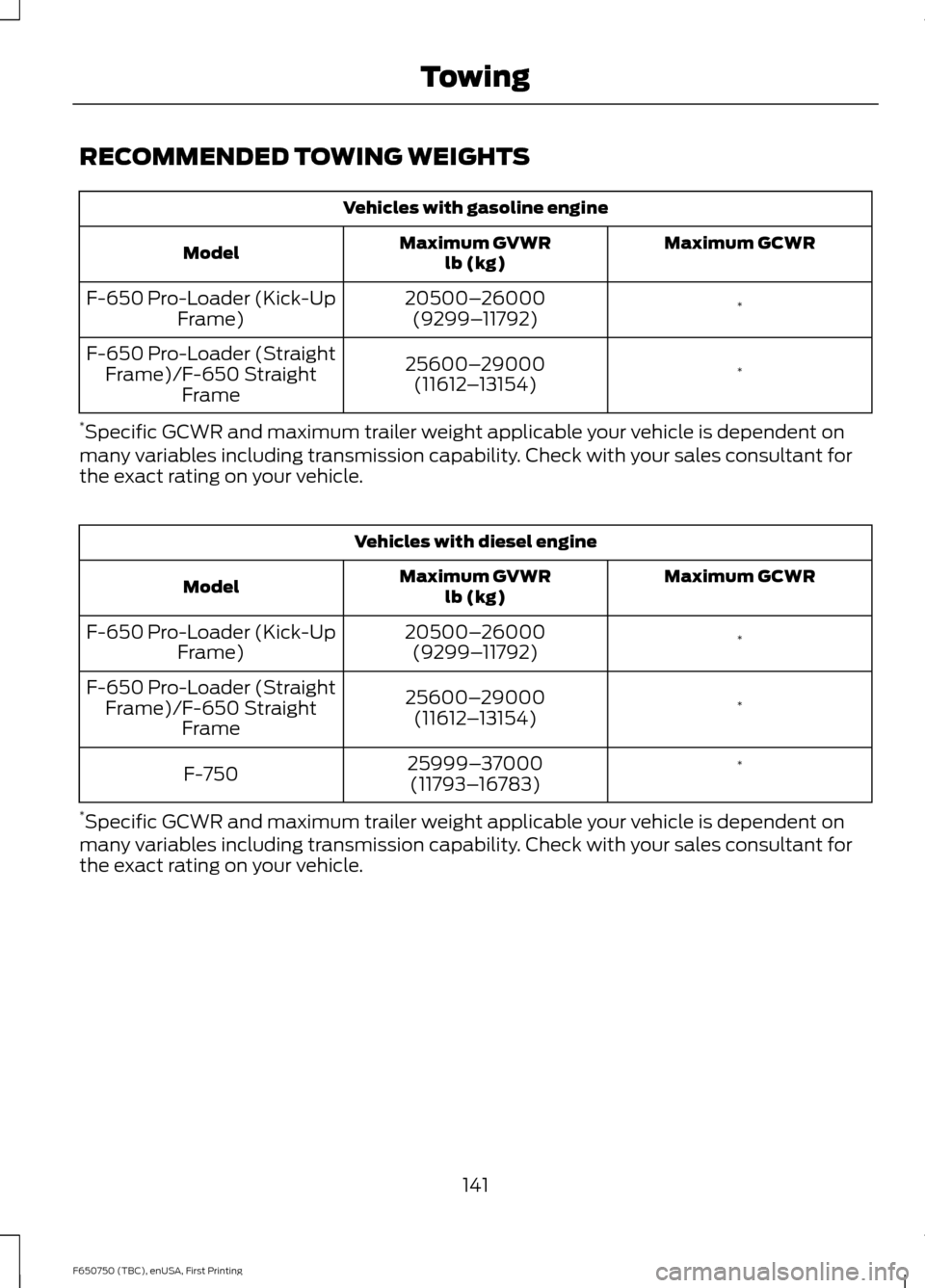
RECOMMENDED TOWING WEIGHTS
Vehicles with gasoline engine
Maximum GCWR
Maximum GVWR
lb (kg)
Model
*
20500–
26000
(9299– 11792)
F-650 Pro-Loader (Kick-Up
Frame)
*
25600–
29000
(11612 –13154)
F-650 Pro-Loader (Straight
Frame)/F-650 Straight Frame
* Specific GCWR and maximum trailer weight applicable your vehicle is dependent on
many variables including transmission capability. Check with your sales consultant for
the exact rating on your vehicle. Vehicles with diesel engine
Maximum GCWR
Maximum GVWR
lb (kg)
Model
*
20500–
26000
(9299– 11792)
F-650 Pro-Loader (Kick-Up
Frame)
*
25600–
29000
(11612 –13154)
F-650 Pro-Loader (Straight
Frame)/F-650 Straight Frame
*
25999– 37000
(11793– 16783)
F-750
* Specific GCWR and maximum trailer weight applicable your vehicle is dependent on
many variables including transmission capability. Check with your sales consultant for
the exact rating on your vehicle.
141
F650750 (TBC), enUSA, First Printing Towing
Page 145 of 379
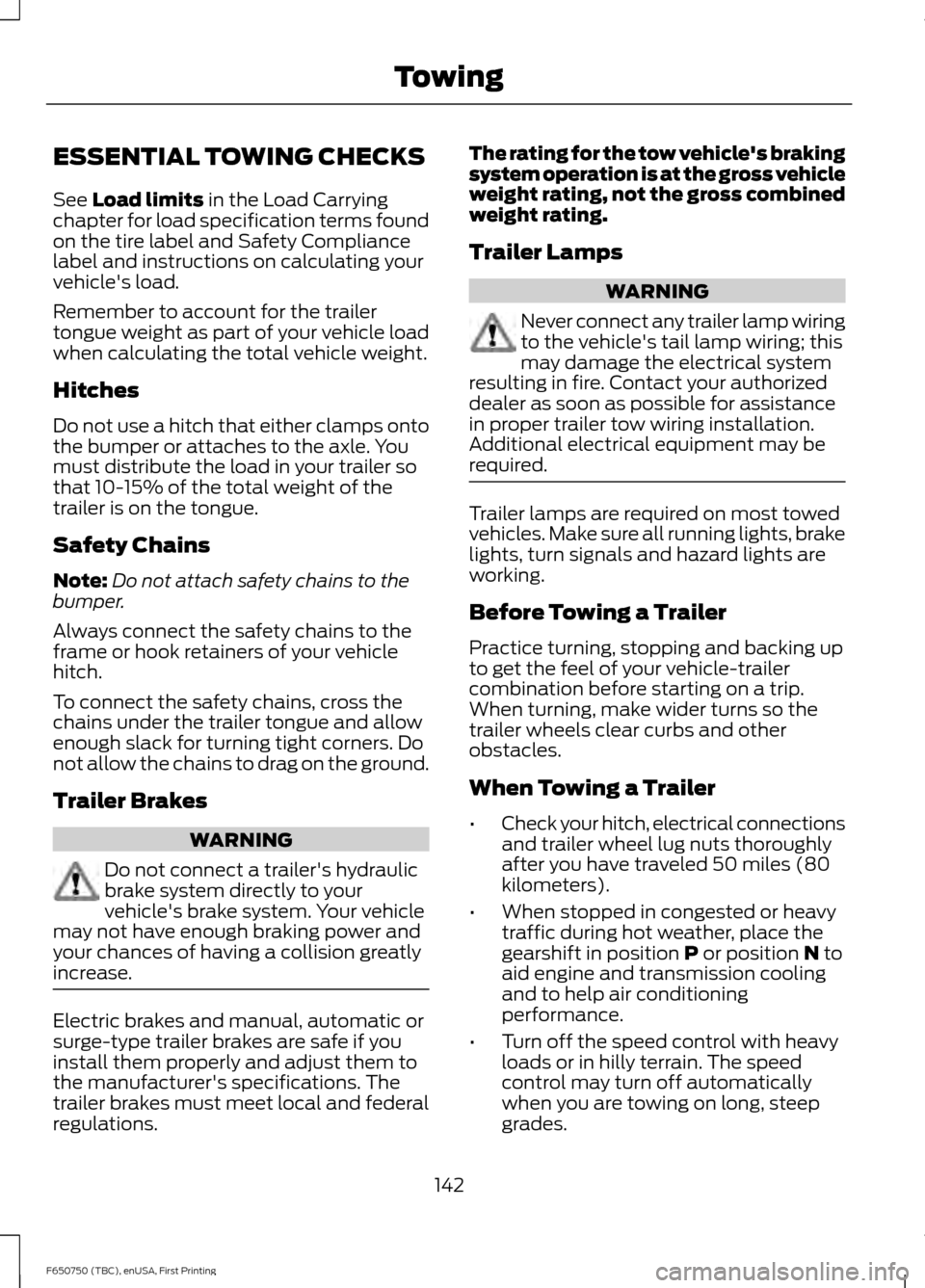
ESSENTIAL TOWING CHECKS
See Load limits in the Load Carrying
chapter for load specification terms found
on the tire label and Safety Compliance
label and instructions on calculating your
vehicle's load.
Remember to account for the trailer
tongue weight as part of your vehicle load
when calculating the total vehicle weight.
Hitches
Do not use a hitch that either clamps onto
the bumper or attaches to the axle. You
must distribute the load in your trailer so
that 10-15% of the total weight of the
trailer is on the tongue.
Safety Chains
Note: Do not attach safety chains to the
bumper.
Always connect the safety chains to the
frame or hook retainers of your vehicle
hitch.
To connect the safety chains, cross the
chains under the trailer tongue and allow
enough slack for turning tight corners. Do
not allow the chains to drag on the ground.
Trailer Brakes WARNING
Do not connect a trailer's hydraulic
brake system directly to your
vehicle's brake system. Your vehicle
may not have enough braking power and
your chances of having a collision greatly
increase. Electric brakes and manual, automatic or
surge-type trailer brakes are safe if you
install them properly and adjust them to
the manufacturer's specifications. The
trailer brakes must meet local and federal
regulations. The rating for the tow vehicle's braking
system operation is at the gross vehicle
weight rating, not the gross combined
weight rating.
Trailer Lamps
WARNING
Never connect any trailer lamp wiring
to the vehicle's tail lamp wiring; this
may damage the electrical system
resulting in fire. Contact your authorized
dealer as soon as possible for assistance
in proper trailer tow wiring installation.
Additional electrical equipment may be
required. Trailer lamps are required on most towed
vehicles. Make sure all running lights, brake
lights, turn signals and hazard lights are
working.
Before Towing a Trailer
Practice turning, stopping and backing up
to get the feel of your vehicle-trailer
combination before starting on a trip.
When turning, make wider turns so the
trailer wheels clear curbs and other
obstacles.
When Towing a Trailer
•
Check your hitch, electrical connections
and trailer wheel lug nuts thoroughly
after you have traveled 50 miles (80
kilometers).
• When stopped in congested or heavy
traffic during hot weather, place the
gearshift in position
P or position N to
aid engine and transmission cooling
and to help air conditioning
performance.
• Turn off the speed control with heavy
loads or in hilly terrain. The speed
control may turn off automatically
when you are towing on long, steep
grades.
142
F650750 (TBC), enUSA, First Printing Towing
Page 146 of 379
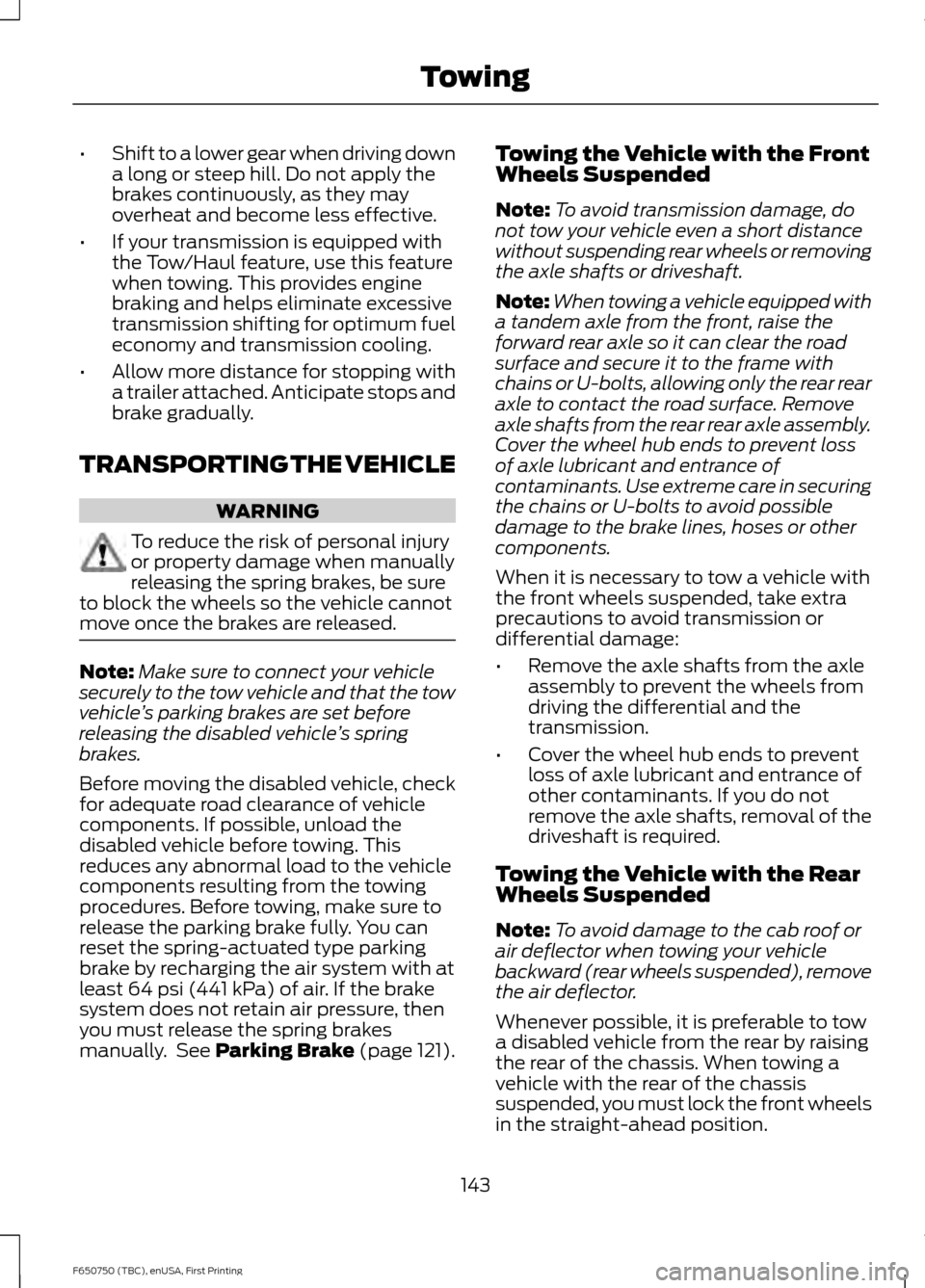
•
Shift to a lower gear when driving down
a long or steep hill. Do not apply the
brakes continuously, as they may
overheat and become less effective.
• If your transmission is equipped with
the Tow/Haul feature, use this feature
when towing. This provides engine
braking and helps eliminate excessive
transmission shifting for optimum fuel
economy and transmission cooling.
• Allow more distance for stopping with
a trailer attached. Anticipate stops and
brake gradually.
TRANSPORTING THE VEHICLE WARNING
To reduce the risk of personal injury
or property damage when manually
releasing the spring brakes, be sure
to block the wheels so the vehicle cannot
move once the brakes are released. Note:
Make sure to connect your vehicle
securely to the tow vehicle and that the tow
vehicle ’s parking brakes are set before
releasing the disabled vehicle ’s spring
brakes.
Before moving the disabled vehicle, check
for adequate road clearance of vehicle
components. If possible, unload the
disabled vehicle before towing. This
reduces any abnormal load to the vehicle
components resulting from the towing
procedures. Before towing, make sure to
release the parking brake fully. You can
reset the spring-actuated type parking
brake by recharging the air system with at
least 64 psi (441 kPa) of air. If the brake
system does not retain air pressure, then
you must release the spring brakes
manually. See
Parking Brake (page 121). Towing the Vehicle with the Front
Wheels Suspended
Note:
To avoid transmission damage, do
not tow your vehicle even a short distance
without suspending rear wheels or removing
the axle shafts or driveshaft.
Note: When towing a vehicle equipped with
a tandem axle from the front, raise the
forward rear axle so it can clear the road
surface and secure it to the frame with
chains or U-bolts, allowing only the rear rear
axle to contact the road surface. Remove
axle shafts from the rear rear axle assembly.
Cover the wheel hub ends to prevent loss
of axle lubricant and entrance of
contaminants. Use extreme care in securing
the chains or U-bolts to avoid possible
damage to the brake lines, hoses or other
components.
When it is necessary to tow a vehicle with
the front wheels suspended, take extra
precautions to avoid transmission or
differential damage:
• Remove the axle shafts from the axle
assembly to prevent the wheels from
driving the differential and the
transmission.
• Cover the wheel hub ends to prevent
loss of axle lubricant and entrance of
other contaminants. If you do not
remove the axle shafts, removal of the
driveshaft is required.
Towing the Vehicle with the Rear
Wheels Suspended
Note: To avoid damage to the cab roof or
air deflector when towing your vehicle
backward (rear wheels suspended), remove
the air deflector.
Whenever possible, it is preferable to tow
a disabled vehicle from the rear by raising
the rear of the chassis. When towing a
vehicle with the rear of the chassis
suspended, you must lock the front wheels
in the straight-ahead position.
143
F650750 (TBC), enUSA, First Printing Towing
Page 147 of 379
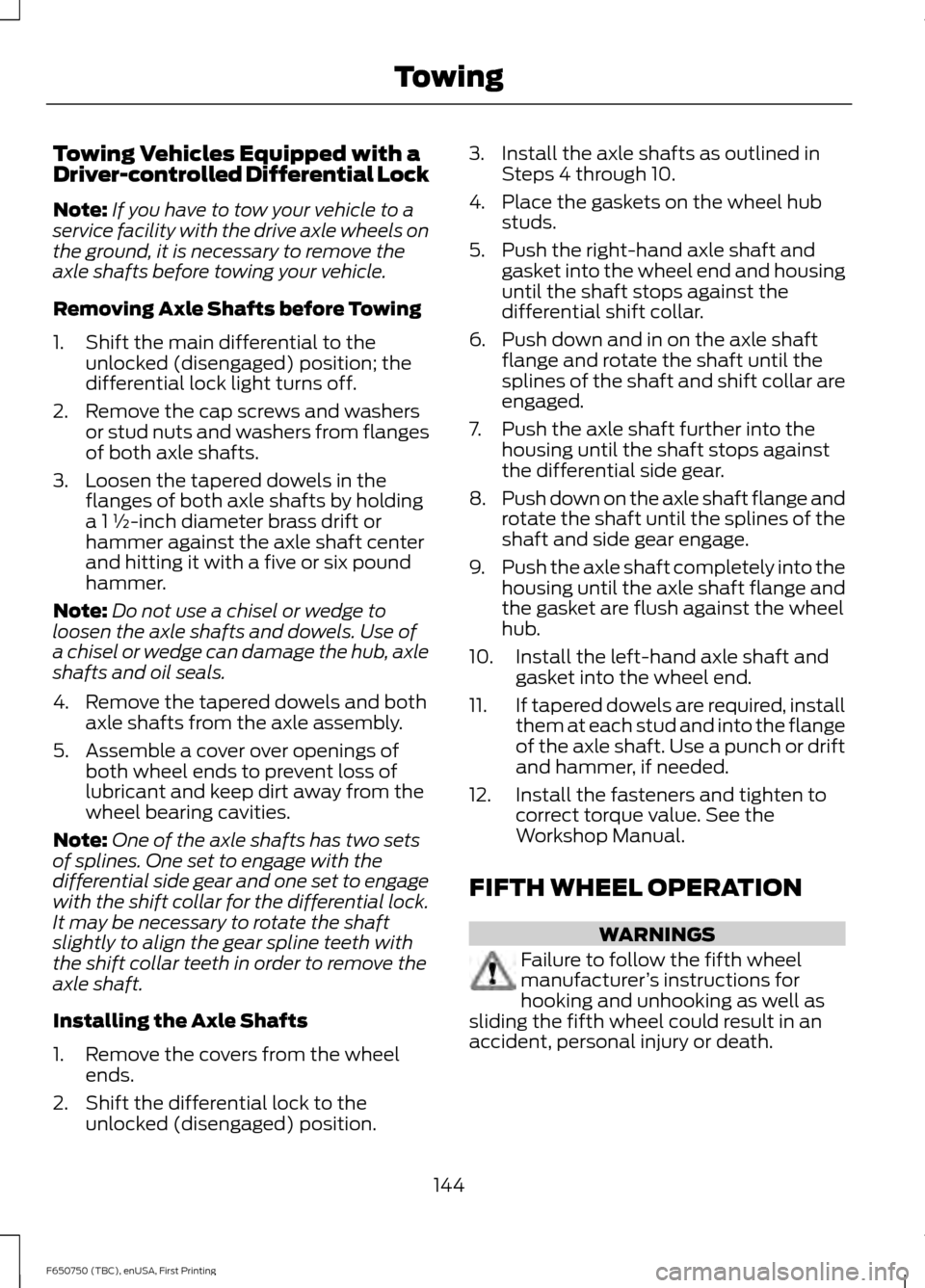
Towing Vehicles Equipped with a
Driver-controlled Differential Lock
Note:
If you have to tow your vehicle to a
service facility with the drive axle wheels on
the ground, it is necessary to remove the
axle shafts before towing your vehicle.
Removing Axle Shafts before Towing
1. Shift the main differential to the unlocked (disengaged) position; the
differential lock light turns off.
2. Remove the cap screws and washers or stud nuts and washers from flanges
of both axle shafts.
3. Loosen the tapered dowels in the flanges of both axle shafts by holding
a 1 ½-inch diameter brass drift or
hammer against the axle shaft center
and hitting it with a five or six pound
hammer.
Note: Do not use a chisel or wedge to
loosen the axle shafts and dowels. Use of
a chisel or wedge can damage the hub, axle
shafts and oil seals.
4. Remove the tapered dowels and both axle shafts from the axle assembly.
5. Assemble a cover over openings of both wheel ends to prevent loss of
lubricant and keep dirt away from the
wheel bearing cavities.
Note: One of the axle shafts has two sets
of splines. One set to engage with the
differential side gear and one set to engage
with the shift collar for the differential lock.
It may be necessary to rotate the shaft
slightly to align the gear spline teeth with
the shift collar teeth in order to remove the
axle shaft.
Installing the Axle Shafts
1. Remove the covers from the wheel ends.
2. Shift the differential lock to the unlocked (disengaged) position. 3. Install the axle shafts as outlined in
Steps 4 through 10.
4. Place the gaskets on the wheel hub studs.
5. Push the right-hand axle shaft and gasket into the wheel end and housing
until the shaft stops against the
differential shift collar.
6. Push down and in on the axle shaft flange and rotate the shaft until the
splines of the shaft and shift collar are
engaged.
7. Push the axle shaft further into the housing until the shaft stops against
the differential side gear.
8. Push down on the axle shaft flange and
rotate the shaft until the splines of the
shaft and side gear engage.
9. Push the axle shaft completely into the
housing until the axle shaft flange and
the gasket are flush against the wheel
hub.
10. Install the left-hand axle shaft and gasket into the wheel end.
11. If tapered dowels are required, install
them at each stud and into the flange
of the axle shaft. Use a punch or drift
and hammer, if needed.
12. Install the fasteners and tighten to correct torque value. See the
Workshop Manual.
FIFTH WHEEL OPERATION WARNINGS
Failure to follow the fifth wheel
manufacturer
’s instructions for
hooking and unhooking as well as
sliding the fifth wheel could result in an
accident, personal injury or death.
144
F650750 (TBC), enUSA, First Printing Towing
Page 148 of 379
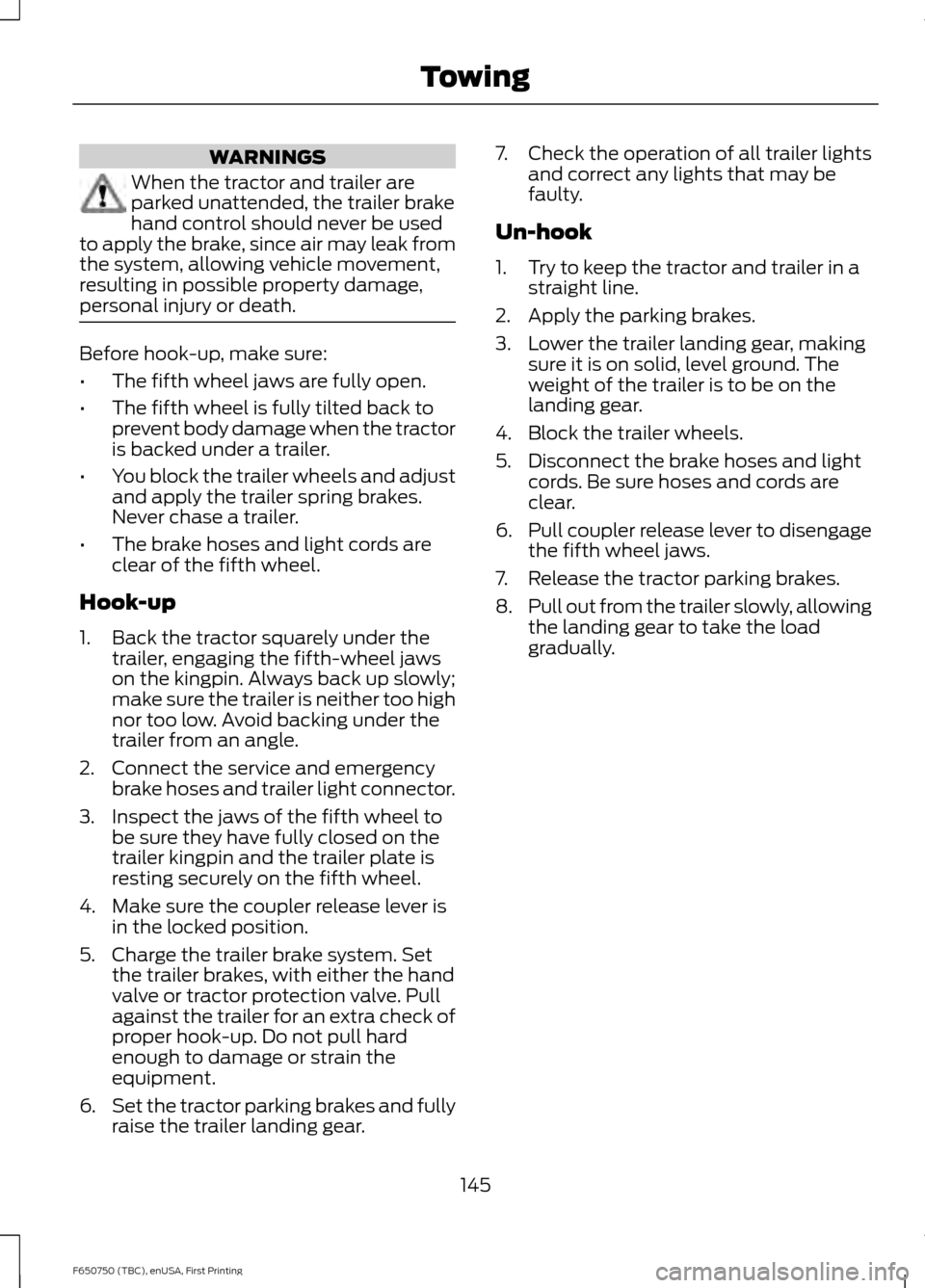
WARNINGS
When the tractor and trailer are
parked unattended, the trailer brake
hand control should never be used
to apply the brake, since air may leak from
the system, allowing vehicle movement,
resulting in possible property damage,
personal injury or death. Before hook-up, make sure:
•
The fifth wheel jaws are fully open.
• The fifth wheel is fully tilted back to
prevent body damage when the tractor
is backed under a trailer.
• You block the trailer wheels and adjust
and apply the trailer spring brakes.
Never chase a trailer.
• The brake hoses and light cords are
clear of the fifth wheel.
Hook-up
1. Back the tractor squarely under the trailer, engaging the fifth-wheel jaws
on the kingpin. Always back up slowly;
make sure the trailer is neither too high
nor too low. Avoid backing under the
trailer from an angle.
2. Connect the service and emergency brake hoses and trailer light connector.
3. Inspect the jaws of the fifth wheel to be sure they have fully closed on the
trailer kingpin and the trailer plate is
resting securely on the fifth wheel.
4. Make sure the coupler release lever is in the locked position.
5. Charge the trailer brake system. Set the trailer brakes, with either the hand
valve or tractor protection valve. Pull
against the trailer for an extra check of
proper hook-up. Do not pull hard
enough to damage or strain the
equipment.
6. Set the tractor parking brakes and fully
raise the trailer landing gear. 7.
Check the operation of all trailer lights
and correct any lights that may be
faulty.
Un-hook
1. Try to keep the tractor and trailer in a straight line.
2. Apply the parking brakes.
3. Lower the trailer landing gear, making sure it is on solid, level ground. The
weight of the trailer is to be on the
landing gear.
4. Block the trailer wheels.
5. Disconnect the brake hoses and light cords. Be sure hoses and cords are
clear.
6. Pull coupler release lever to disengage
the fifth wheel jaws.
7. Release the tractor parking brakes.
8. Pull out from the trailer slowly, allowing
the landing gear to take the load
gradually.
145
F650750 (TBC), enUSA, First Printing Towing
Page 149 of 379
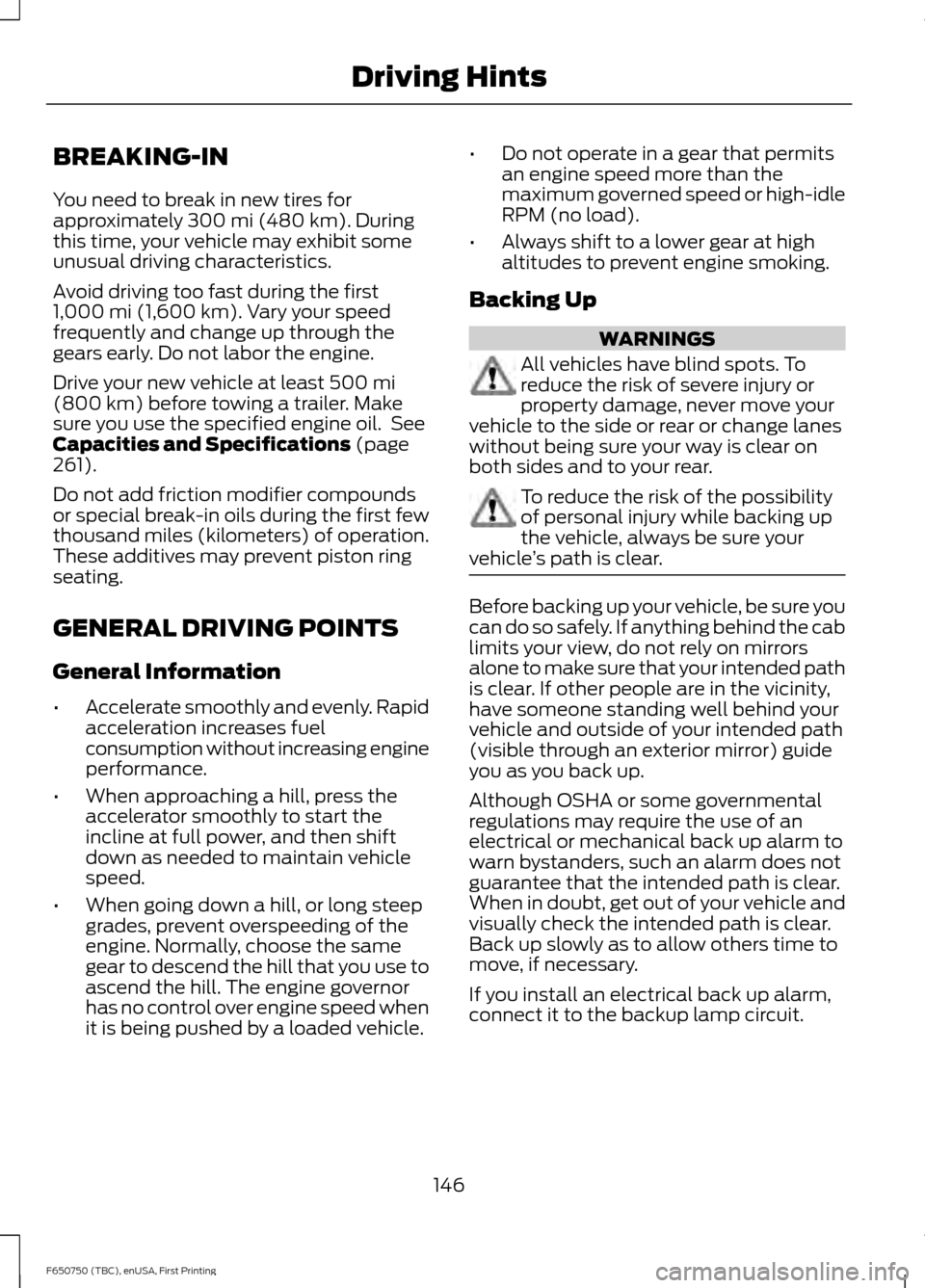
BREAKING-IN
You need to break in new tires for
approximately 300 mi (480 km). During
this time, your vehicle may exhibit some
unusual driving characteristics.
Avoid driving too fast during the first
1,000 mi (1,600 km)
. Vary your speed
frequently and change up through the
gears early. Do not labor the engine.
Drive your new vehicle at least
500 mi
(800 km) before towing a trailer. Make
sure you use the specified engine oil. See
Capacities and Specifications
(page
261).
Do not add friction modifier compounds
or special break-in oils during the first few
thousand miles (kilometers) of operation.
These additives may prevent piston ring
seating.
GENERAL DRIVING POINTS
General Information
• Accelerate smoothly and evenly. Rapid
acceleration increases fuel
consumption without increasing engine
performance.
• When approaching a hill, press the
accelerator smoothly to start the
incline at full power, and then shift
down as needed to maintain vehicle
speed.
• When going down a hill, or long steep
grades, prevent overspeeding of the
engine. Normally, choose the same
gear to descend the hill that you use to
ascend the hill. The engine governor
has no control over engine speed when
it is being pushed by a loaded vehicle. •
Do not operate in a gear that permits
an engine speed more than the
maximum governed speed or high-idle
RPM (no load).
• Always shift to a lower gear at high
altitudes to prevent engine smoking.
Backing Up WARNINGS
All vehicles have blind spots. To
reduce the risk of severe injury or
property damage, never move your
vehicle to the side or rear or change lanes
without being sure your way is clear on
both sides and to your rear. To reduce the risk of the possibility
of personal injury while backing up
the vehicle, always be sure your
vehicle ’s path is clear. Before backing up your vehicle, be sure you
can do so safely. If anything behind the cab
limits your view, do not rely on mirrors
alone to make sure that your intended path
is clear. If other people are in the vicinity,
have someone standing well behind your
vehicle and outside of your intended path
(visible through an exterior mirror) guide
you as you back up.
Although OSHA or some governmental
regulations may require the use of an
electrical or mechanical back up alarm to
warn bystanders, such an alarm does not
guarantee that the intended path is clear.
When in doubt, get out of your vehicle and
visually check the intended path is clear.
Back up slowly as to allow others time to
move, if necessary.
If you install an electrical back up alarm,
connect it to the backup lamp circuit.
146
F650750 (TBC), enUSA, First Printing Driving Hints
Page 150 of 379
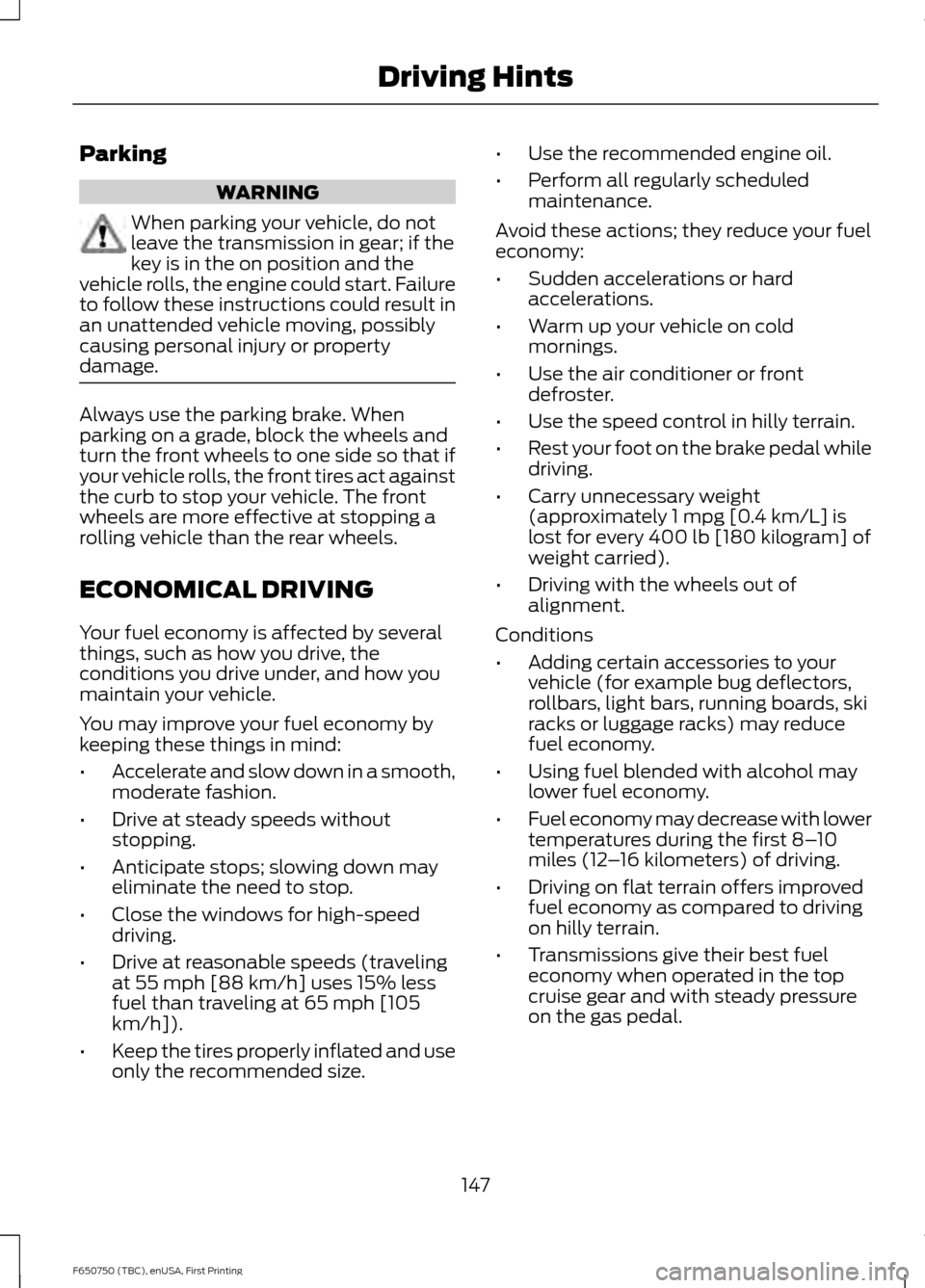
Parking
WARNING
When parking your vehicle, do not
leave the transmission in gear; if the
key is in the on position and the
vehicle rolls, the engine could start. Failure
to follow these instructions could result in
an unattended vehicle moving, possibly
causing personal injury or property
damage. Always use the parking brake. When
parking on a grade, block the wheels and
turn the front wheels to one side so that if
your vehicle rolls, the front tires act against
the curb to stop your vehicle. The front
wheels are more effective at stopping a
rolling vehicle than the rear wheels.
ECONOMICAL DRIVING
Your fuel economy is affected by several
things, such as how you drive, the
conditions you drive under, and how you
maintain your vehicle.
You may improve your fuel economy by
keeping these things in mind:
•
Accelerate and slow down in a smooth,
moderate fashion.
• Drive at steady speeds without
stopping.
• Anticipate stops; slowing down may
eliminate the need to stop.
• Close the windows for high-speed
driving.
• Drive at reasonable speeds (traveling
at 55 mph [88 km/h] uses 15% less
fuel than traveling at 65 mph [105
km/h]).
• Keep the tires properly inflated and use
only the recommended size. •
Use the recommended engine oil.
• Perform all regularly scheduled
maintenance.
Avoid these actions; they reduce your fuel
economy:
• Sudden accelerations or hard
accelerations.
• Warm up your vehicle on cold
mornings.
• Use the air conditioner or front
defroster.
• Use the speed control in hilly terrain.
• Rest your foot on the brake pedal while
driving.
• Carry unnecessary weight
(approximately 1 mpg [0.4 km/L] is
lost for every 400 lb [180 kilogram] of
weight carried).
• Driving with the wheels out of
alignment.
Conditions
• Adding certain accessories to your
vehicle (for example bug deflectors,
rollbars, light bars, running boards, ski
racks or luggage racks) may reduce
fuel economy.
• Using fuel blended with alcohol may
lower fuel economy.
• Fuel economy may decrease with lower
temperatures during the first 8– 10
miles (12 –16 kilometers) of driving.
• Driving on flat terrain offers improved
fuel economy as compared to driving
on hilly terrain.
• Transmissions give their best fuel
economy when operated in the top
cruise gear and with steady pressure
on the gas pedal.
147
F650750 (TBC), enUSA, First Printing Driving Hints